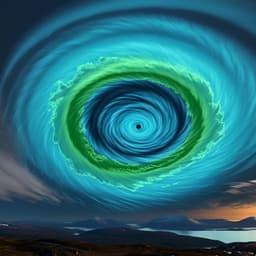
Earth Sciences
Arctic warming contributes to increase in Northeast Pacific marine heatwave days over the past decades
S. Song, S. Yeh, et al.
Marine heatwaves are on the rise, threatening marine ecosystems. This research by Se-Yong Song, Sang-Wook Yeh, Hyerim Kim, and Neil J. Holbrook explores how Arctic warming drives an increase in Northeast Pacific marine heatwave days, emphasizing the importance of addressing projected Arctic climate changes in future adaptations.
~3 min • Beginner • English
Introduction
The study investigates why marine heatwave (MHW) days have increased in the Northeast Pacific, particularly during boreal summer (JJA). MHWs—prolonged extreme warm ocean events—have intensified globally with anthropogenic warming, causing major ecological and socioeconomic impacts. The Northeast Pacific has experienced notable events such as the 2013–2015 and 2019 "Blob" heatwaves. While previous work highlights roles for local air–sea fluxes, ocean advection, and large-scale modes (e.g., North Pacific Oscillation, NPO), this paper hypothesizes that accelerated Arctic warming and associated sea ice loss since the late 1990s have modified atmospheric circulation toward a positive NPO-like state and reduced low-level clouds over the Northeast Pacific, thereby enhancing surface warming and increasing MHW days. The purpose is to test this hypothesis using observations/reanalyses and an idealized coupled model designed to isolate Arctic forcing.
Literature Review
The paper synthesizes prior evidence that MHWs have become more frequent, longer, and more intense due to anthropogenic warming, with observed increases and projected future amplification. Documented impacts include coral bleaching, ecosystem mortality, fishery disruptions, and biodiversity threats. Regional drivers of MHWs vary and include local net downward heat flux anomalies, ocean advection, and teleconnections associated with large-scale climate modes. For the Northeast Pacific, recent MHWs have been linked to anomalously high sea level pressure patterns associated with the NPO and persistent low pressure in the Gulf of Alaska, which reduce ocean heat loss, weaken winds, decrease cloud cover, and shoal the mixed layer—conditions favorable for extreme SST anomalies. Emerging work suggests the Atlantic meridional overturning circulation slowdown may modulate MHWs hemispherically. The literature on Arctic amplification indicates strong local feedbacks and potential mid-latitude circulation impacts, including on the NPO, though mechanisms remain debated. This study builds on and extends these findings by proposing and testing a causal pathway from Arctic warming to increased Northeast Pacific summer MHW days via atmospheric circulation and cloud cover changes.
Methodology
Data and detection: Daily SST from NOAA OISST v2.1 (1/4° grid; late 1981–2019) and monthly Arctic sea ice concentration (SIC) from NOAA NSIDC CDR (25 km; since 1979) were used. Atmospheric variables and surface heat fluxes were from ERA5 (1°). Anomalies were computed relative to 1982–2019 climatologies (daily for SST; monthly for others). MHWs were identified using the Hobday et al. definition: daily SST exceeding the seasonally varying 90th percentile threshold for at least 5 consecutive days; robustness to 95th percentile and longer minimum durations (10, 20, 30 days) was tested. Seasonal/annual MHW days were computed as total days within each period.
Statistical analyses: Trends were assessed using linear regression with significance tested via two-sided Student’s t-tests accounting for serial correlation (effective degrees of freedom). Spatial pattern correlations between trend maps (SST vs. MHW days) were area-weighted (cosine latitude). Composite analyses targeted years since the late 1990s with JJA MHW days >10 (2004, 2009, 2011, 2013, 2014, 2015, 2019), examining preceding MJJ SIC, SLP, 850-hPa winds, and low-level cloud cover (LCC). The NPO index was defined as SLP anomaly differences between northern (50–65°N, 140–170°W) and southern (25–45°N, 150–175°W) lobes. The LCC index was the LCC anomaly averaged over 28–44°N, 135–155°W. Probability distributions of daily SST anomalies and mean SST were compared between 1982–1999 and 2000–2019.
Model experiment: An idealized coupled GFDL CM2.1 experiment (ART_Exp) isolated Arctic warming impacts by restoring SSTs north of 65°N to linearly interpolated historical daily SST (1951–2019) with a 5-day restoring timescale; CO2 was fixed at 353 ppm (1989 level). Outside the restoring region, the ocean, atmosphere, and sea ice were fully coupled. Thirty ensemble members with different initial conditions were run; ensemble means emphasized forced responses and minimized internal variability. The simulated SIC closely followed observations due to thermodynamic balance with restored SST. Trends, composites, and distributional analyses mirrored those applied to observations.
Key Findings
- Northeast Pacific MHW days: The average annual total number of MHW days (1982–2019) is 29; during JJA it is 7.4 days. The largest significant upward trend in MHW days occurs in JJA: 6.23 days per decade (1982–2019). Concurrently, JJA SST shows an upward trend of 0.39 °C per decade.
- Spatial linkage: The spatial pattern correlation between JJA trends in SST and MHW days is 0.59 over the Northeast Pacific.
- Temporal linkage: Area-averaged JJA SST correlates strongly with JJA MHW days (detrended r = 0.75; 99% significance).
- Period comparison: Mean JJA SST increased from 16.4 °C (1982–1999) to 17.0 °C (2000–2019), a 0.6 °C shift (99% significance). Mean MHW days rose from ~2.2 (1982–1999) to ~12.1 (2000–2019), with the difference significant at 95%.
- MHW properties: JJA MHW days correlate with MHW frequency (r = 0.96), duration (r = 0.80), and intensity (r = 0.52), all significant at 95%, indicating increased days are due to longer and more frequent events.
- Preconditioning: Years with long JJA MHW days (>10) show preceding (MJJ) reduced Arctic SIC, a +NPO-like SLP dipole pattern with anomalous easterlies/weakened westerlies over the Northeast Pacific, reduced surface latent heat loss, and decreased LCC. Reduced LCC increases downward shortwave radiation, supporting SST warming; latent heat flux anomalies peak about one month before shortwave anomalies.
- Trends (1982–2019): A +NPO-like trend in SLP and 850-hPa winds and a decreasing trend in LCC during MJJ, alongside an accelerated JJA SST warming trend in the Northeast Pacific, especially after the late 1990s (0.65 °C decade⁻¹ in 2000–2019 vs 0.41 °C decade⁻¹ before).
- Distribution shift: The probability distribution of daily JJA SST anomalies shifts toward warmer values in 2000–2019 with an enhanced right tail, consistent with increased warm extremes and MHW days.
- Modeling support: ART_Exp simulates a +NPO-like circulation trend, decreasing LCC, and a positive JJA SST trend over the Northeast Pacific. The ensemble-mean JJA SST is higher by 0.14 °C in 2000–2019 vs 1982–1999 (99% significance), with a warm-shifted SST anomaly distribution. Modeled trend magnitudes are smaller than observed, consistent with isolation of Arctic forcing and reduced internal variability.
Discussion
Findings support the hypothesis that accelerated Arctic warming and sea ice loss since the late 1990s have contributed to increased JJA MHW days in the Northeast Pacific by altering midlatitude atmospheric circulation toward a positive NPO-like pattern, reducing low-level cloud cover, suppressing latent heat loss, and enhancing downward shortwave radiation. This chain of processes yields sustained upper-ocean warming and more frequent and longer MHWs. The strong observational correlations, composites, and consistent trends, along with supportive idealized coupled model results isolating Arctic forcing, indicate a plausible causal pathway from Arctic amplification to Northeast Pacific summer MHW increases. While tropical Pacific variability (e.g., ENSO) can initiate or modulate specific events (e.g., 2013–2015, 2019), the Arctic influence provides a background state more conducive to MHW occurrence. Differences between observations and simulations (e.g., spatial extent of circulation anomalies, SST trend structure) likely reflect model design (fixed CO2), biases, and the exclusion of non-Arctic forcings and internal variability in the ensemble mean. The results imply that ongoing Arctic warming will likely continue to elevate MHW risk, necessitating consideration of high-latitude influences in regional MHW prediction, adaptation, and mitigation planning.
Conclusion
The study demonstrates that Arctic warming has likely contributed substantially to the increase in boreal summer marine heatwave days in the Northeast Pacific over recent decades. Observational analyses reveal significant upward trends in JJA MHW days and SST, with strong associations to a +NPO-like atmospheric circulation trend and declining low-level cloud cover. Idealized coupled model experiments that isolate Arctic warming reproduce these circulation and cloud changes and the associated SST warming, corroborating the proposed mechanism. These insights highlight the need to incorporate projected Arctic changes into MHW risk assessments and to strengthen climate mitigation and adaptation strategies for Northeast Pacific marine ecosystems. Future work should employ multi-model large-ensemble frameworks to assess model dependence, quantify uncertainties, and further disentangle the roles of Arctic forcing, greenhouse gas increases outside the Arctic, and internal variability.
Limitations
- Causality inference: Many analyses are correlational; while the model experiment supports a mechanism, observational correlations do not alone prove causation.
- Model design constraints: The idealized experiment fixes CO2 at 353 ppm (1989 level), omitting time-varying greenhouse gas forcing outside the Arctic and potentially affecting trends (e.g., negative SST trend pre-1989).
- Ensemble-mean damping: By design, internal variability is minimized, leading to smaller trend magnitudes versus observations and possible mismatch in spatial patterns (e.g., circulation confined to higher latitudes, SST response shifted toward the North American west coast).
- Model biases: Cold bias in western-to-central North Pacific and warm bias in the east during JJA may under/over-estimate regional MHW days.
- Single-model dependency: Results come from one coupled model; ensemble size adequacy and model dependence remain concerns, suggesting a need for multi-model ensembles.
- Other forcings: Observed trends may also be influenced by non-Arctic forcings and internal decadal variability (e.g., ENSO-related influences), not fully isolated here.
Related Publications
Explore these studies to deepen your understanding of the subject.







